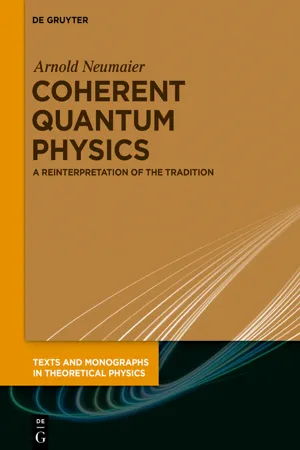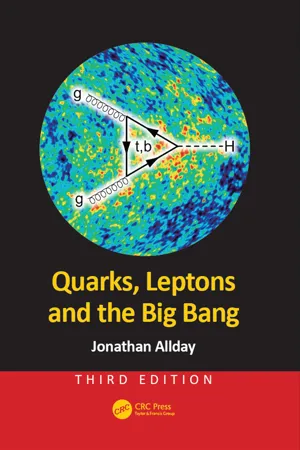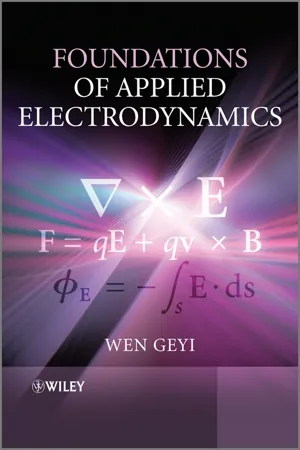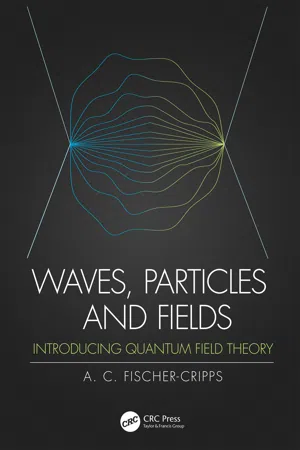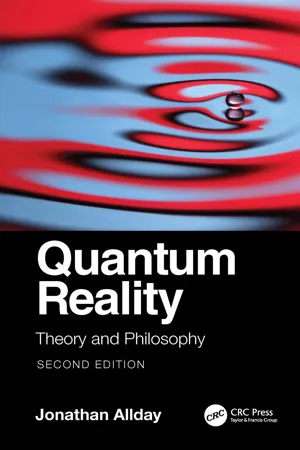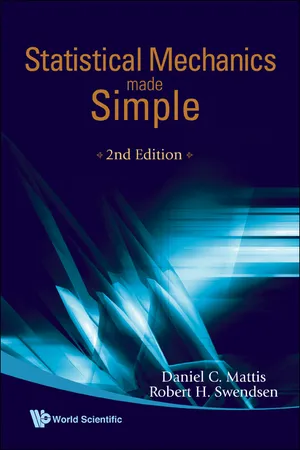Physics
Quantum Field Theory
Quantum Field Theory is a theoretical framework that combines quantum mechanics with special relativity to describe the behavior of subatomic particles. It treats particles as excited states of underlying fields, and interactions between particles are described in terms of exchanges of other particles. Quantum Field Theory has been successful in predicting and explaining a wide range of phenomena in particle physics.
Written by Perlego with AI-assistance
Related key terms
Related key terms
1 of 4
Related key terms
1 of 3
9 Key excerpts on "Quantum Field Theory"
- eBook - ePub
Coherent Quantum Physics
A Reinterpretation of the Tradition
- Arnold Neumaier(Author)
- 2019(Publication Date)
- De Gruyter(Publisher)
In physics practice, it is often unavoidable to switch between representations featuring different levels of detail. The fundamental theory of elementary particles and fields, with the most detailed description, is Quantum Field Theory. Since Quantum Field Theory is fundamental, the simpler quantum mechanics of particles is necessarily a derived description.How to obtain the quantum mechanics of particles from relativistic interacting Quantum Field Theory is a nontrivial problem. The traditional textbook description in terms of scattering and associated propagators does not give a description at finite times. On the other hand, books on molecular quantum electrodynamics such as Liu [175 ] or Salam [257 ], which need to work with a finite time dynamics, make heuristic approximations and do not really derive the particle picture from QED.In the fundamental reality, represented by objective properties of Quantum Field Theory, expressed at finite times in hydrodynamic terms, fields concentrated in fairly narrow regions move along uncertain flow lines determined by effective field equations.In the particle description, these fields are somehow replaced by a quantum mechanical model of moving particles. The uncertainty is now accounted for by the uncertain value of the positionq ( t )of each particle together with its uncertaintyσ, at any time t, providing not a continuous trajectory, but a fuzzy world tube defining their location. The momentum of the quantum particles is also uncertain. For example, the momentum vector of a particle at CERN is measured by collecting information from many responding wires and applying curve fitting techniques to get an approximate curve of positions at all times, and inferring from its derivative an uncertain momentum. Similar techniques are used for particle tracks on photographic plates or in bubble chambers.q ( t )How one finds from a relativistic quantum field description of a beam a corresponding quantum mechanical particle description has hardly received attention so far. Whereas informally, particles are considered to be elementary excitations of the quantum fields, this can be given an exact meaning only for free field theories. In interacting relativistic quantum fields, the notion is, at finite times, approximate only. - eBook - ePub
- R. Campbell(Author)
- 2015(Publication Date)
- Palgrave Macmillan(Publisher)
Many physicists, puzzled by the so-called particle-wave duality which characterizes the sub-atomic world, were inclined to regard such phenomena as ‘convenient fictions’, or a set of quasi-descriptions of only heuristic significance. For them, only the mathematical equations were significant. David Mermin’s summary of such interpretations is often quoted (and wrongly attributed to Feynman): “Shut up and calculate!” (2004). That approach, however, is profoundly unsatisfying. The fact that electron microscopes now enable researchers actually to see atoms and molecules supports an interpretation of atoms as every bit as real as stones and people. To allow realist interpretations of atoms, but disallow realist interpretations of what they are composed of, would be quite arbitrary and unjustifiably sceptical. Rather, recognizing that quantization also occurs at macroscopic levels opens the way to understanding QFT realistically too – as describing real activity in the world.Thus interpreted, the sea of quantum fields is best conceptualized as a foam of spontaneous, quantized excitations: excitations which have various properties. In (most) field-to-field interactions, some of these properties, such as charge – insofar as they are well-defined – are conserved and QFT can usually predict when such conservations obtain, or at least the probabilities of their doing so. It is part of the non-locality of these interactions that one cannot characterize what is happening as particular excitations following particular trajectories from one position to another.Rather, the movement of excitations is represented in QFT as a wave of potentialities: potentialities for quantized and conserved interactions. One mathematical mode of analysis, devised by Feynman, supposes that all possible paths of ‘particles’ are traversed simultaneously. These ‘paths’ are not the motions of a single particle, but the possible ways in which a field can evolve in time over space. This mathematical representation illustrates the sense in which there are no particular excitations moving on particular trajectories; in integrating the probabilities over all these possible paths, it is presumed that all possible trajectories are ‘traversed’, although only one quantized interaction can actually occur. - eBook - ePub
- Jonathan Allday(Author)
- 2016(Publication Date)
- CRC Press(Publisher)
CHAPTER 11Exchange Forces
In this chapter, we will look in more detail at the general theory of forces. This theory has been extremely successful in providing a mathematical model for fundamental forces and has had a profound influence on the way that we think about the origin of the universe. The price has been the difficulty in extracting from it a clear physical picture of what is happening. At the subatomic level, forces are not simply ‘pushes and pulls’.11.1 QUANTUM FIELD THEORIES
We have steadily been building up a picture of a world composed of a collection of particles interacting with force fields. These interactions cause a transfer of energy and momentum between the particle and the field and the result is an exchange particle, which is a moving disturbance of the field.While these exchange particles are field disturbances, they have all the characteristics displayed by matter particles, with one exception: they are bosons rather than fermions. This is an important distinction, but it does not affect the following argument in any crucial sense.An important stage in the development of quantum theory was the discovery that the particle nature of waves was mirrored by a wave-like nature to particles. Duplicating that thought in terms of fields, if our exchange particles are the particle aspects of force fields, then why can’t electrons and other matter particles be the disturbances of matter fields?We are moving into an area of physics called relativistic Quantum Field Theory. Probably the most important step we need to take is dissolving some of our residual thinking about particles as tiny lumps of matter with certain fixed properties such as mass. Our language does not help here, as we continue to talk about particles where some other term, perhaps quanta - eBook - ePub
- Wen Geyi(Author)
- 2011(Publication Date)
- Wiley(Publisher)
10Quantization of Electromagnetic FieldsThe true logic in this world lies in probability theory. –james Maxwell Reality is merely an illusion, albeit a very persistent one. —Albert EinsteinIn the late 1800s and early 1900s, there was an increase in the number of experimental observations that could not be explained by classical physics. Physical scientists began to believe that the physics needs a complete reformulation. This led to the birth of modern physics, which rests on three pillars: the quantum theory, special relativity and general relativity.The quantum theory was invented to describe the physics of small systems, such as atoms and nuclei, and was pioneered by Max Planck (German physicist, 1858–1947), Albert Einstein, Niels Henrik David Bohr (Danish physicist, 1885–1962) and Louis de Broglie (French physicist, 1892–1987). It is the work by the German physicist Werner Heisenberg (1901–1976) and the Austrian physicist Erwin Rudolf Josef Alexander Schrödinger (1887–1961) that made the early quantum theory become what is known as quantum mechanics today. Quantum mechanics has replaced Newtonian mechanics as the correct description of small particle systems.On the atomic and molecular scale, both the charged particles and electromagnetic fields must obey the laws of quantum mechanics, which leads to quantum electrodynamics. In classical electrodynamics, the field strengths may take arbitrary values. In quantum electrodynamics, however, the field strengths cannot be identically zero. Quantum electrodynamics is remarkable for its incredible accuracy in predicting small particle systems, and it has been widely used for calculating the interaction of electromagnetic radiation with atomic and molecular matter. It should be mentioned that a mathematically rigorous Quantum Field Theory for describing the behavior of elementary particles is still not available. - eBook - ePub
Applied Bohmian Mechanics
From Nanoscale Systems to Cosmology
- Xavier Oriols Pladevall, Jordi Mompart, Xavier Oriols Pladevall, Jordi Mompart(Authors)
- 2019(Publication Date)
- Jenny Stanford Publishing(Publisher)
Section 8.2.2 .Now let us generalize these results to particles with spin. When spin is present, the analogy with the classical Hamilton–Jacobi equation is less useful. The crucial requirement is the consistency with the purely probabilistic interpretation (8.52) . This is achieved by generalizing (8.137) and (8.138) to=dX a μd sV a μ,(8.140) V a μ=,j a μψ †ψ(8.141) wherej a μis a conserved current given by (8.109) for spin1 2particles and (8.121) for spin 1 particles. The compatibility with (8.52) is provided by the generalization of (8.139) :+∂ψ †ψ∂ s.∑a = 1n∂a μ(= 0)ψ †ψV a μ(8.142) 8.4 Quantum Field Theory
8.4.1 Main Ideas of QFT and Its Bohmian Interpretation
So far, we have been considering systems with a fixed number n of particles. However, in many physical systems the number of particles is not fixed. Instead, particles may be created or destroyed. To describe such processes, a more general formalism is needed. This formalism is known as QFT.The simplest way to understand the kinematics of QFT is as follows. Let H(n)denote the Hilbert space associated with QM of a fixed number n of particles, where n ≥ 1. An element of this Hilbert space is a quantum state of n particles, denoted abstractly by |n〉. In fact, the case n = 0 can also be included by defining a new trivial one-dimensional Hilbert space H (0) . This trivial space has only one linearly independent element denoted by |0〉, which represents the vacuum, i.e., the state with no particles. From all these Hilbert spaces, one can construct a single Hilbert space H containing all of them as subspaces, through a direct sum:H =⊕n = 0∞H≡( n )H⊕( 0 )H⊕( 1 )H⊕ ⋯ .( 2 )(8.143) QFT is nothing but the theory of states in the Hilbert space H . A general state in this space is a linear combination of the form|Ψ 〉= - eBook - ePub
- Britannica Educational Publishing, Erik Gregersen(Authors)
- 2010(Publication Date)
- Britannica Educational Publishing(Publisher)
ō in Japan proved that they could rid the theory of its embarrassing infinities by a process known as renormalization. Basically, renormalization acknowledges all possible infinities and then allows the positive infinities to cancel the negative ones. The mass and charge of the electron, which are infinite in theory, are then defined to be their measured values.Once these steps have been taken, QED works beautifully. It is the most accurate Quantum Field Theory scientists have at their disposal. In recognition of their achievement, Feynman, Schwinger, and Tomonaga were awarded the Nobel Prize for Physics in 1965. Dirac had been similarly honoured in 1933.QUANTUM CHROMODYNAMICS: DESCRIBING THE STRONG FORCE
As early as 1920, when Ernest Rutherford named the proton and accepted it as a fundamental particle, it was clear that the electromagnetic force was not the only force at work within the atom. Something stronger had to be responsible for binding the positively charged protons together and thereby overcoming their natural electrical repulsion. The discovery in 1932 of the neutron showed that there are (at least) two kinds of particles subject to the same force. Later in the same year, Werner Heisenberg in Germany made one of the first attempts to develop a Quantum Field Theory that was analogous to QED but appropriate to the nuclear binding force.THE NUCLEAR BINDING FORCEAccording to Quantum Field Theory, particles can be held together by a “charge-exchange” force, which is carried by charged intermediary particles. Heisenberg’s application of this theory gave birth to the idea that the proton and neutron were charged and neutral versions of the same particle—an idea that seemed to be supported by the fact that the two particles have almost equal masses. Heisenberg proposed that a proton, for example, could emit a positively charged particle that was then absorbed by a neutron. The proton thus became a neutron, and vice versa. The nucleus was no longer viewed as a collection of two kinds of immutable billiard balls but rather as a continuously changing collection of protons and neutrons that were bound together by the exchange particles flitting between them. - eBook - ePub
Waves, Particles and Fields
Introducing Quantum Field Theory
- Anthony C. Fischer-Cripps(Author)
- 2019(Publication Date)
- CRC Press(Publisher)
1616.1 Introduction
Although Dirac’s relativistic equation predicted the existence of antiparticles, his equation was still a single-particle based approach where the particle remained intact. The number of particles is conserved. However, we know that mass and energy can be converted from one to the other. Particles can be created and annihilated. We need a theory which can account for this.In the quantum particle theory, we have seen that physical quantities such as energy and momentum are replaced by operators and those operators act on the wave function. The wave functions are the solutions of the Schrödinger or Dirac wave equations. The boundary conditions imposed by the wave equation determines the allowable energies, the eigenvalues, of the wave function. The amplitude (squared) of the wave function gives the probability density for a particle to be in one of the allowable energy states. That is, for example, given an electron, we can determine the probability of it being located at a particular place or the probability of it having a specific energy or momentum.For photons, we have an electromagnetic field. The wave equation is the set of Maxwell’s equations. The wave function is the four-potential. However, the states are not quantised. It is a classical field. The photon is not a part of it. We know this is not a sufficient description of the electromagnetic field because of the observed quantum effects associated with the existence of photons.The concept of a quantised field was implicit in Dirac’s negative-energy sea. According to Dirac’s idea, the vacuum of space-time is populated by an infinite number of negative energy, negatively charged electrons. When a positive energy electron is created, it leaves behind a positively charged hole which behaves as if it had positive energy, an anti-electron. Dirac thought originally that these anti-electrons were protons, but it was soon discovered that anti-electrons actually existed. - eBook - ePub
Quantum Reality
Theory and Philosophy
- Jonathan Allday(Author)
- 2022(Publication Date)
- CRC Press(Publisher)
Section 32.7 ), but great progress has been made on the other three.We are now bordering on areas where our theoretical and mathematical understanding doesn’t allow us to tread, fascinating subjects though these are. Hence, from this point, our discussion becomes rather qualitative.The various options for these operators are constrained by physical laws, the requirements of relativity, for example, but physicists have had to use a degree of theoretical imagination to come up with good prospects to be checked by experiment. In the case of the electromagnetic interaction between two electrons, a suitable combination turns out to be(Φ ^Dirac *(e)ϕ ^Φ ^Diracis something more than a simple complex conjugate, creation and annihilation operators have swapped places), andΦ ^Dirac *ϕ ^is the boson field of photons associated with the electromagnetic interaction. The electron charge, e, acts as a ‘coupling’ between the fields.Given an element of this type, quantum field theorists can calculate the energy of the interaction as a series of mathematical terms. Taking a few terms in the series gives an approximation to the actual answer that increases in accuracy as you include more terms in the final sum8 . It is also possible to calculate something called the scattering matrix or S matrix:S =which can be used to obtain the probability of a given interaction occurring.〈final field configuration〉|initial field configurationS ^|In essence, we are filling in the spiky cloud at the centre of Figure 32.2 , but not with one single diagram. Instead, we use a sum of possibilities represented by Feynman diagrams.These diagrams can cause a certain degree of confusion, especially if they are interpreted too literally. In Figure 32.3 I have drawn the standard Feynman diagram for scattering one electron off another via an electromagnetic interaction. Compare this with Figure 32.2 , where I drew a diagram to pictorially capture the interaction operator and its effect on quanta. We should look at the Feynman diagram in a similar manner and ‘see’ how various creation and annihilation operators for electrons and photons have contributed to building the overall picture. That’s not the end of the story though9 . Each diagram represents a term in a series that would have to be evaluated in its entirety to get a completely accurate answer. There are other terms, or diagrams, that need to be included, such as Figure 32.4 - eBook - ePub
Statistical Mechanics Made Simple
2nd Edition
- Daniel C Mattis, Robert Swendsen(Authors)
- 2008(Publication Date)
- WSPC(Publisher)
Chapter 11Some Uses of Quantum Field Theory in Statistical Physics11.1. Outline of the ChapterThis final chapter spins several apparently disconnected threads into a common skein. They include diffusion-limited reactions, the Hohenberg-Mermin-Wagner theorems (proving the lack of long-range order in low-dimensions), thermodynamic Green functions and their equations of motion as popularized in the 1960's and finally, the application of this methodology to the study of glass — the ultimate random medium.In the first instance, what starts as an essentially classical topic is best understood in the terminology of a modified Bose-Einstein Quantum Field Theory (QFT). First formulated by Doi in the 1970's,a 'b the quantum-field-theoretic formulation of the master equation of diffusion-limited processes allows a systematic investigation in any number of nonequilibrium events, ranging from fluorescence to explosions. In the remaining instances some applications of QFT to statistical physics are noted, including a theory of glass from the point of view of a quasi-elastic medium in which the normal modes — phonons — are scattered strongly and at random.We begin by examining diffusion — the macroscopic consequence of multiple microscopic random walks. For simplicity we shall assume all processes occur on hypercubic lattices with unit cell a by a by a.c11.2. Diffusion on a Lattice: Standard FormulationIn all dimensions d ≥ 1, it is diffusion (alias Brownian motion) that brings the reactants into contact and nourishes the reactions. Let us first consider the example of a single entity (particle, vacancy, or whatever) diffusing on the N vertices of a space lattice. For simplicity, we restrict random hopping from any given point R to its near-neighbors situated at R + δ. Given P(R|t) as the probability that R is occupied at time t, the master equation for diffusion
Index pages curate the most relevant extracts from our library of academic textbooks. They’ve been created using an in-house natural language model (NLM), each adding context and meaning to key research topics.
Explore more topic indexes
Explore more topic indexes
1 of 6
Explore more topic indexes
1 of 4
